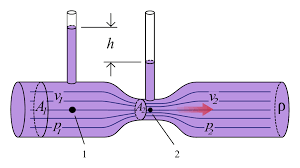Question
Question: Derive a formula to measure the rate of flow of a liquid through a Venturimeter....
Derive a formula to measure the rate of flow of a liquid through a Venturimeter.
Solution
To solve these types of questions we must have complete knowledge of a venturimeter. A venturimeter can be defined as a device which can be used to measure the rate of flow of a particular liquid through a pipe. We can say that Bernoulli’s principle is used in a venturimeter for an incomprehensible fluid.
Complete step-by-step solution: -
To derive the formula to measure the rate of flow of a liquid through a venturimeter we must know it’s working and construction. A venturimeter consists of a horizontal tube having two openings, one wide and the other narrow with a cross sectional area of A1 and A2 respectively. Let us assume that the velocity of the fluid at these openings is v1 and v2 at these openings with a pressure of P1 and P2. The diagram of a venturimeter is attached herewith for better understanding:

Assuming the flow of fluid to be streamlined with a density of ρ and using Bernoulli’s theorem, we get the equation as:
P1+21ρv12=P2+21ρv22⇒P1−P2=21ρ(v22−v12)
Also, we know that the difference in level in the vertical tubes is h, thus
P1−P2=ρgh
On combining both the equations:
ρgh=21ρ(v22−v12)⇒v22−v12=2gh−equation 1
From equation of continuity, we know that:
A1v1=A2v2⇒A2A1=v1v2−equation 2
From equation 1, we get:
v12[(v12v22)−1]=2gh
From equation 2, we get:
v12[(A22A12)−1]=2gh⇒v12=A22A12−A222gh∴v1=A2A12−A222gh
Hence the rate of flow of a liquid through venturimeter comes out to be:
v1=A2A12−A222gh
Note: The Venturimeter keeps in mind the equation of continuity which means that if a liquid enters a pipe, then it must also leave the pipe from the other end. Hence a venturimeter used Bernoulli’s equation and equation of continuity on a fluid that is incompressible in nature.
